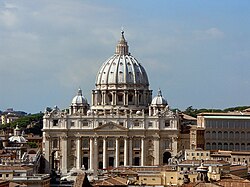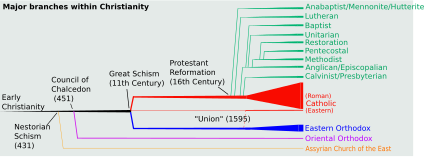
Back مسيحية غربية Arabic مسيحيه غربيه ARZ Qərb xristianlığı Azerbaijani Заходняе хрысціянства Byelorussian Западнохристиянски църкви Bulgarian পশ্চিমা খ্রিস্টধর্ম Bengali/Bangla Cristianisme occidental Catalan Západní křesťanství Czech Vestkirken Danish Westliches Christentum German
| Part of a series on |
| Christianity |
|---|
 |



Western Christianity is one of two subdivisions of Christianity (Eastern Christianity being the other). Western Christianity is composed of the Latin Church and Western Protestantism, together with their offshoots such as the Old Catholic Church, Independent Catholicism and Restorationism.
The large majority of the world's 2.3 billion Christians are Western Christians (about 2 billion: 1.2 billion Latin Catholic and 1.17 billion Protestant).[3][4] One major component, the Latin Church, developed under the bishop of Rome. Out of the Latin Church emerged a wide variety of independent Protestant denominations, including Lutheranism and Anglicanism, starting from the Protestant Reformation in the 16th century, as did Independent Catholicism in the 19th century. Thus, the term "Western Christianity" does not describe a single communion or religious denomination but is applied to distinguish all these denominations collectively from Eastern Christianity.
The establishment of the distinct Latin Church, a particular church sui iuris of the Catholic Church, coincided with the consolidation of the Holy See in Rome, which claimed primacy since Antiquity. The Latin Church is distinct from the Eastern Catholic Churches, also in full communion with the Pope in Rome, and from the Eastern Orthodox Church and Oriental Orthodox Churches, which are not in communion with Rome. These other churches are part of Eastern Christianity. The terms "Western" and "Eastern" in this regard originated with geographical divisions mirroring the cultural divide between the Hellenistic East and Latin West and the political divide between the Western and Eastern Roman empires. During the Middle Ages, adherents of the Latin Church, irrespective of ethnicity, commonly referred to themselves as "Latins" to distinguish themselves from Eastern Christians.[5]
Western Christianity has played a prominent role in the shaping of Western civilization.[6][7][8][9] With the expansion of European colonialism from the Early Modern era, the Latin Church, in time along with its Protestant secessions, spread throughout the Americas, much of the Philippines, Southern Africa, pockets of West Africa, and throughout Australia and New Zealand. Thus, when used for historical periods after the 16th century, the term "Western Christianity" does not refer to a particular geographical area but is used as a collective term for all these.
Today, the geographical distinction between Western and Eastern Christianity is not nearly as absolute as in Antiquity or the Middle Ages, due to the spread of Christian missionaries, migrations, and globalisation. As such, the adjectives "Western Christianity" and "Eastern Christianity" are typically used to refer to historical origins and differences in theology and liturgy rather than present geographical locations.[citation needed]
While the Latin Church maintains the use of the Latin liturgical rites, Protestant denominations and Independent Catholicism use various liturgical practices.
The earliest concept of Europe as a cultural sphere (instead of simply a geographic term) appeared during the Carolingian Renaissance of the 9th century, which included territories that practiced Western Christianity at the time.[10]
- ^ "CATHOLIC ENCYCLOPEDIA: Agnus Dei (In Liturgy)". www.newadvent.org. Retrieved 2 January 2024.
- ^ Centre, UNESCO World Heritage. "Vatican City". UNESCO World Heritage Centre. Retrieved 2 January 2024.
- ^ "Status of Global Christianity, 2024, in the Context of 1900–2050" (PDF). Center for the Study of Global Christianity, Gordon-Conwell Theological Seminary. Retrieved 23 May 2024.
Protestants: 625,606,000; Independents: 421,689,000; Unaffiliated Christians: 123,508,000
- ^ Center, Pew Research (19 December 2011). "Global Christianity - A Report on the Size and Distribution of the World's Christian Population". Pew Research Center's Religion & Public Life Project. Retrieved 1 February 2024.
- ^ "Distinguishing the terms: Latins and Romans". Orbis Latinus.
- ^ Perry, Marvin; Chase, Myrna; Jacob, James; Jacob, Margaret; Von Laue, Theodore H. (1 January 2012). Western Civilization: Since 1400. Cengage Learning. p. XXIX. ISBN 978-1-111-83169-1 – via Google Books.
- ^ "Roman Catholicism". Encyclopædia Britannica. 11 August 2023.
Roman Catholicism, Christian church that has been the decisive spiritual force in the history of Western civilization.
- ^ Hayas, Caltron J.H. (1953). Christianity and Western Civilization. Stanford University Press. p. 2.
That certain distinctive features of our Western civilization—the civilization of western Europe and America—have been shaped chiefly by Judaeo – Graeco – Christianity, Catholic, and Protestant.
- ^ Orlandis, José (1993). A Short History of the Catholic Church. Four Courts Press.
- ^ Dr. Sanjay Kumar (2021). A Handbook of Political Geography. K.K. Publications. p. 127.